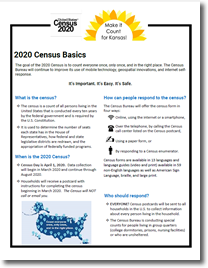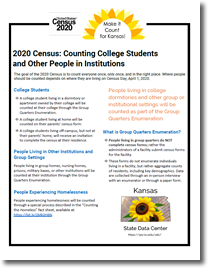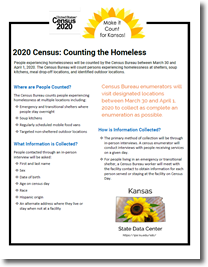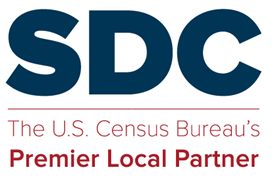2020 Census
Kansas Counts
 KansasCounts.org was launched in September 2019 to support 2020 Census outreach efforts across the state. Resources include
a comprehensive community organizing local action guide, promotional videos, talking points, and much more.
KansasCounts.org was launched in September 2019 to support 2020 Census outreach efforts across the state. Resources include
a comprehensive community organizing local action guide, promotional videos, talking points, and much more.What is the Census?
- The census is mandated by the U.S. Constitution.
- The census is a count of everyone residing in the United States: in all 50 states, Washington, D.C., Puerto Rico, U.S. Virgin Islands, Guam, the Commonwealth of the Northern Mariana Islands, and American Samoa. This includes people of all ages, races, ethnic groups, both citizens and non-citizens.
- The next census day is April 1, 2020.
- Your participation in the census is required by law.
- It takes less than 10 minutes to complete. The 2020 Census questionnaire asks only a few simple questions of each person -- name, relationship, gender, age and date of birth, race, and whether the respondent owns or rents his or her home.
- Federal law protects the personal information you share during the census. The Census Bureau does not release or share information that identifies individual respondents or their household for 72 years.
2020 Census Factsheets
 2020 Census Basics (PDF) Microsoft Word (DOCX) (rev. 6/27/2019) |
 Counting College Students (PDF) Microsoft Word (DOCX) |
 Counting the Homeless (PDF) Microsoft Word (DOCX) |
| 2020 Census flyers are being made available in PDF and Word. Please feel free to use and modify, without attribution, for your specific needs. | ||
CENSUS 101 flyer (PDF)
Why is the Census important?
- MONEY - Census data are used to distribute $300 billion in federal funds to local, state and tribal governments each year. Congress uses census data to allocate funds under various federal grant programs to state governments. Many state-funded grant programs also rely on census data. Because the annual population estimates use the decennial census counts as a base, if a community's population is undercounted in the decennial census, these funds get misallocated for an entire decade.
- Counting for Dollars: Kansas, report from George Washington University outlining the federal funding coming to Kansas based on the 2010 Census
- Federal Funding for Rural America: The Role of the Decennial Census, George Washington University
- Counting for Dollars 2020: The Role of the Decennial Census in the Geographic Distribution of Federal Funds, George Washington University
-
"Counting for Dollars: Why It Matters", The Leadership Conference Education Fund
- INFRASTRUCTURE - Census data guide local decision-makers in important community planning efforts, including where to build new roads, hospitals and schools.
- POWER - Census data are used to apportion Congressional seats to states. Census data affect your voice in Congress by determining how many seats each state will have in the U.S. House of Representatives.
2020 Apportionment
2020 Apportionment data were released on April 26, 2021. Kansas has a total population of 2,937,880 (3.0% growth since 2010) and retains four congressional seats.

Click map for larger image or download PDF.
2020 Census Redistricting
Redistricting data (PL 94-171) were released on August 12, 2021. Explore maps and tables in our Kansas Statistical Abstract at: https://ksdata.ku.edu/ksdata/ksah/population/ or browse the map below.
More Information
- Gallery of 2020 Census Outreach and Planning Tools for Local Communities
- U.S. Census Bureau's 2020 Census Portal
- U.S. Census Bureau's Response Outreach Area Mapper (ROAM)
Interactive map with Low Response Score along with 2010-14 ACS and 2010 Census data at the Census Tract level. - Census 2020 Hard to Count Map
Interactive map to identify hard to reach populations.



